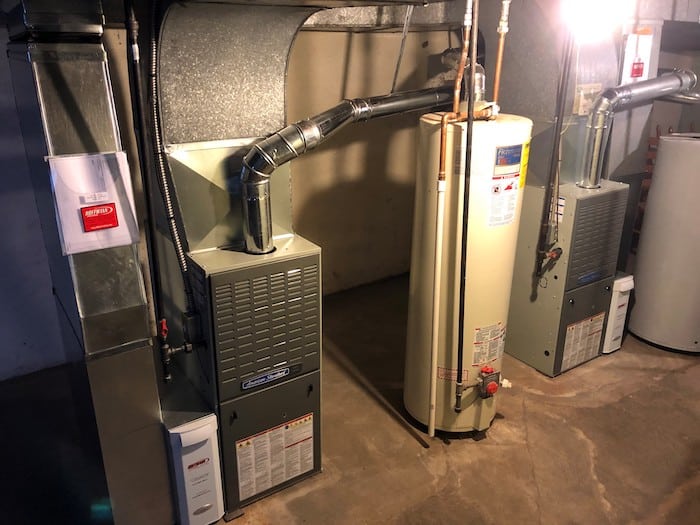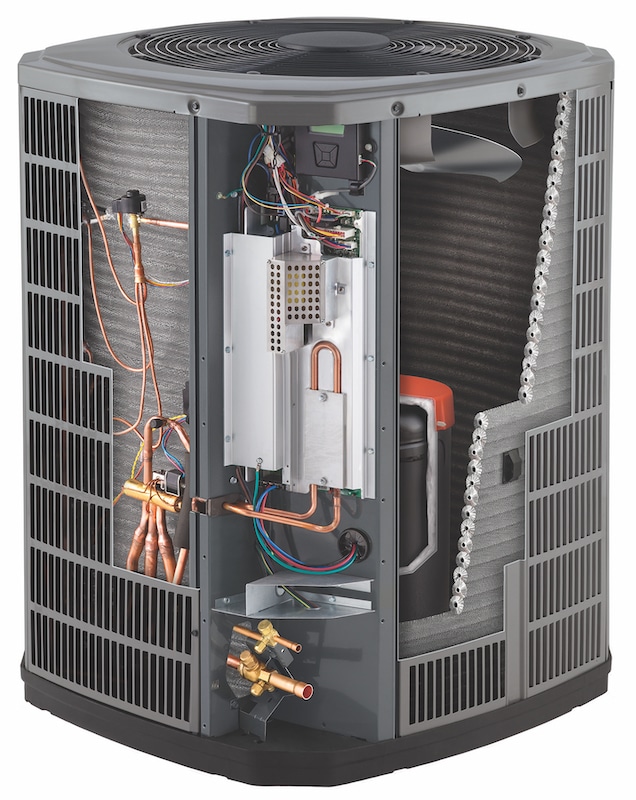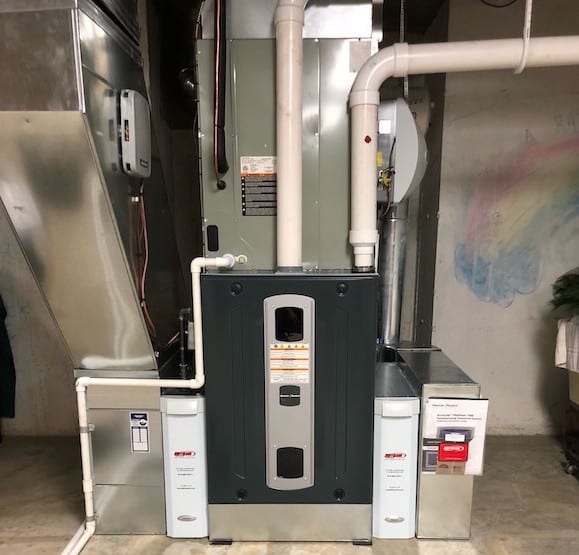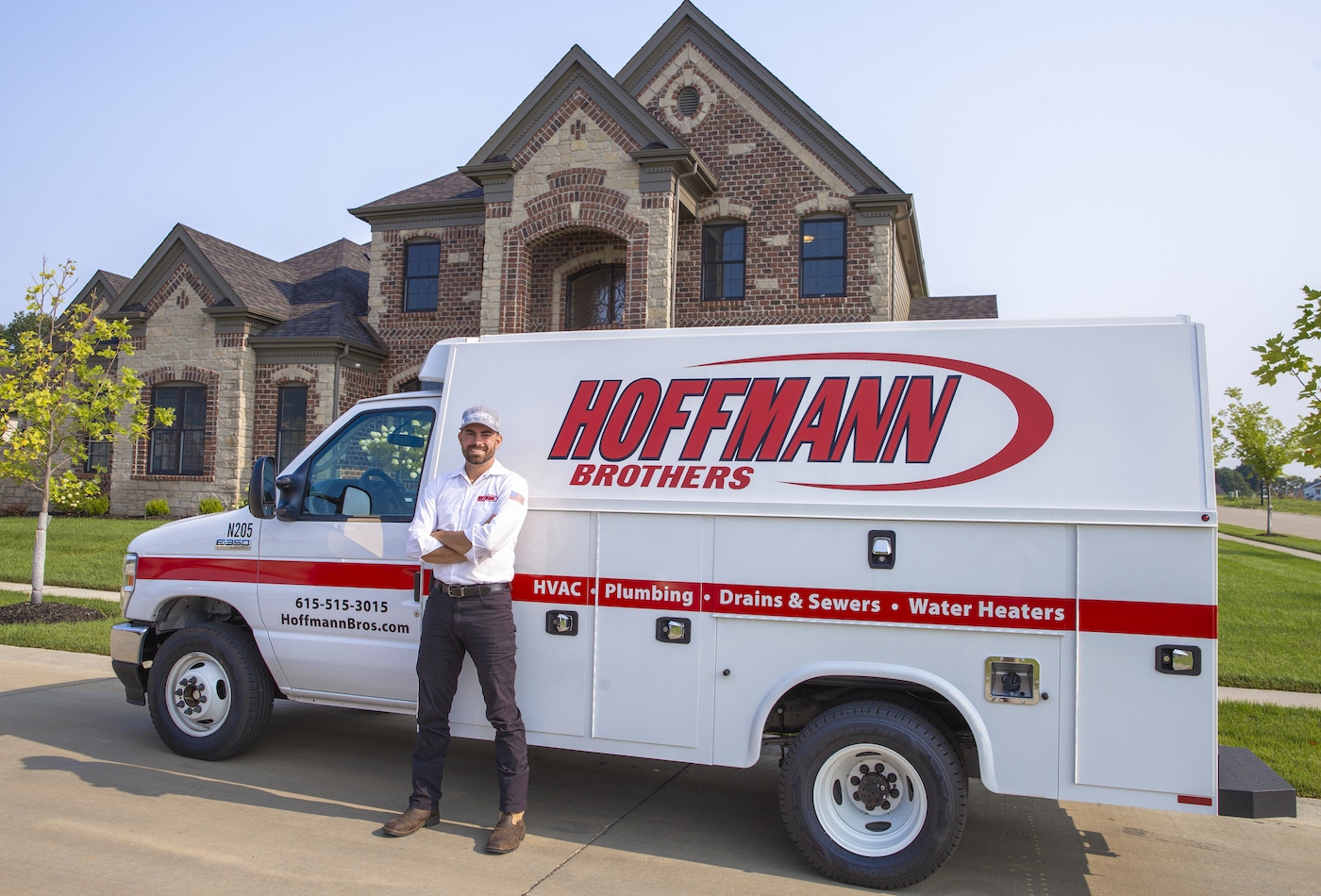The Difference Between a Heat Pump and Furnace
Furnaces generate heat by burning fuel – gas or oil. Hot fuel warms the air, pushing it through the ducts and heating your home. Electric options are also available. Heat pumps are “heat relocators,” moving hot air or water wherever necessary to heat or cool your space. i.e., moving hot air inside to heat, or outside to cool.

What Is a Heat Pump?

Heat Pump Definition
A heat pump is a heating and air conditioning system that extracts warm air from one location and delivers it to another. These locations are referred to as the source side, where the hot air comes from, and the load side, where the heat is transferred.
The source and load sides change depending on whether the home is cooled or heated. For example, when heating, the source side is outdoors, where the warm air is taken and dispersed inside the house, making it warmer – even in below-freezing temperatures.
Due to the processes necessary to heat and cool with a heat pump, the system comprises two units: an indoor unit and outdoor unit [1].
Basic Heat Pump Types
There are several different kinds of heat pumps, though all are a variation of these basic types:
- Air Source – Heat is taken from outdoors and transferred indoors, heating your space.
- Ground Source – Water runs through underground pipes, where the temperature remains consistent year-round. The water is warmed by the temperature of the Earth and is then used to warm your space. The pipes are installed through a process known as geothermal drilling, wherein the ground is excavated to install a piping system for the heat pump unit.
Types of Heat Pumps Systems
Each variation functions differently and may have different costs for installation. One may be a better fit for your home, depending on budget, climate, and the presence of ductwork. It is important to know the differences. Combination heat pumps include:
Ground-to-Ground Heat Pump
This heat pump system requires geothermal drilling to install underground piping. In this system, water travels through the pipes and is warmed by the earth’s temperature, creating the “source water.” Once warmed, the source water runs up and into a heat exchanger, where the source water is used to heat the “load water.” The load water then travels through the heating system, heating your home.
Ground-to-Air Heat Pump
Ground-to-air systems also require geothermal drilling. The water in this system is warmed in the same way as a ground-to-ground system. But, once up the pipes, the source water travels through a coil, causing the coil to heat up. When air is blown across the coil, it heats the air. This air is then circulated through the ductwork to warm your space.
Air-to-Air Heat Pump
Air-to-air systems are the most common heat pump system in the United States. In this system, heat is obtained from the air on the source side – outdoors – and is transported to a refrigerant. The refrigerant travels through a coil in the ductwork, heating the coil. The load side air is blown across the hot coil, transferring the heat, and is then sent from the ducts to warm the space.
Air-to-Ground Heat Pump
Also referred to as an air-to-water heat pump. Though it is a ground source variant, this system does not involve drilling. Instead, the heat is collected from air on the source side, just like an air-to-air system, and transferred to a refrigerant.
The refrigerant is cycled through a heat exchanger, heating the load-side water. In this system, there are a few possible uses for this water, which can be:
- Cycled through a heat exchanger for use as domestic hot water,
- Sent through a coil to heat your space using a duct system, or
- Pumped to a zone manifold to be used for hydronic heat – an extremely energy-efficient and cost-effective way to heat a space.
Though more expensive to install initially, geothermal heat pumps are quieter than air source pumps, last longer, and typically need less maintenance to the outdoor unit since the piping system is underground [2]. Geothermal heat pumps also come with tax incentives and other savings over time.
In recent years, heat pump technology has evolved significantly, allowing it to comfortably heat a space, even when outside temperatures are below freezing. According to the US Department of Energy, they still manage to cut electricity usage in half, compared to furnaces or baseboard heaters [3]. Even in colder climates, don’t count out a heat pump vs furnace.
Heat Pump Pros and Cons
What Is a Furnace?

Furnace Definition
A furnace is a central heating system that burns combustible fuel to create heat for your space. Unlike heat pumps, furnace systems include only one indoor unit. However, a furnace vs. heat pump’s purpose is solely to provide heat, meaning a secondary unit may need to be installed to provide cooling in the warmer months.
All fuel-powered furnaces have four main parts to function:
- Burners deliver and burn fuel.
- Heat Exchangers: Their job is to transfer the heat from burned fuel into the load air, through a system of coils, much like the air load source heat pump systems.
- A Blower Fan: Does the vital job of distributing – or blowing – the hot air throughout your home.
- A Flue Filter: A metal tube that acts as the exhaust for the furnace system by venting the gaseous by-products of the fuel out of your air and home.
Types of Furnace Systems
Furnaces are mostly fuel-powered, though electric systems are also available and are often more cost-effective than their natural-gas counterparts.
There are four types of furnaces:
Gas Furnace
Gas furnaces are used to heat approximately 48 percent of US homes, according to the Climate Central Organization [4], making it the most common – and often the cheapest – choice for long-term use.
This unit requires a connection to a municipal gas line, which some homeowners may not have access to. Gas systems burn the gas drawn from the municipal line and send it to the heat exchanger to warm the air. Some gas furnaces can be converted to run using propane. This option is more efficient in terms of cost, energy, and carbon footprint.
Oil Furnace
Oil furnaces are a good alternative for homeowners without gas lines. Oil units are less fuel efficient than gas furnaces. However, the initial installation of the unit is often cheaper.
Oil furnaces function similarly to gas units, wherein the oil is pulled into the system, ignited, and used to heat the air. The fuel for this unit must be stored separately in a tank with a fuel line attached.
Electric Furnace
Electric furnaces function precisely how you would expect – by running on electricity.
This option is fuel-free and operates much like a hairdryer by sucking air into the heat exchanger, where electric heating elements warm the air before it is distributed. Electric units are often smaller and do not require any tanks or a flue filter, making the installation less complicated and less expensive as a result.
Wood Furnace
Wood furnaces can be used as stand-alone units or in conjunction with a gas or oil furnace. These units must be manually loaded with firewood and can be installed indoors or outdoors.
Indoor Wood Furnace
As the wood is burned, the smoke travels up into the heat exchanger where the load source air is heated and blown through the ductwork to warm your entire home. The smoke then exits the unit via the chimney.
Indoor units can be equipped with a glass window, making it resemble a fireplace, meaning it can be on display instead of hidden like most other units. They also tend to burn better and produce less smoke than outdoor units.
Outdoor Wood Furnace
Outdoor units heat using a boiler system, this means that the burned wood is used to heat a water reservoir. Once heated, the water travels through an underground piping system and enters a heat exchanger to be used in a regular furnace system.
This system poses less fire hazard than an indoor wood unit, though it requires walking through wintery or wet conditions to reload the unit with wood.
Furnace Pros and Cons
Heat Pump Furnace Combo: What is a Dual Fuel System?
A dual-fuel system is a heating and air conditioning system made of both a heat pump and a gas furnace. The dual system gauges the outdoor temperature and operates on the most efficient system.
Typically, a dual system will operate using the heat pump during milder temperatures and switch automatically to the furnace system as the outdoor temperature drops. Since this system operates based on efficiency, it is no surprise that dual-fuel heaters save homeowners the most money while giving them the best possible comfort within their space.
Installing a Dual Fuel System
Dual fuel system installation may incur additional costs when a home is not properly equipped to hold one of the units. For example, a home that does not have access to a municipal gas line may have to pay extra upon installation to properly equip its furnace to burn propane or to install an electric furnace instead.
Heat Pump Tax Incentives, Credits and Rebates

Federal Heat Pump Programs
In many parts of the United States, heat pump tax incentives and rebates can make these systems even more affordable by reducing installation costs and increasing long-term savings from reduced energy bills.
The federal government offers several tax credits for installing renewable energy systems such as geothermal or air-source heat pumps. The Residential Renewable Energy Tax Credit covers up to 30 percent of eligible expenses for qualified solar electric systems, solar water heating systems, fuel cells, small wind turbines, and geothermal heat pumps.
Also available are state-level incentives that vary from state to state but typically offer additional financial assistance with installation costs through either grants or loans. For example, Arizona’s Solar Tax Credit offers up to $1000 for residential solar installations and California’s Self-Generation Incentive Program provides up to $3,000 in incentives for customers who install energy storage systems or fuel cells. Check with your local utility company or state government office to find out what tax credits or rebates are available in your area.
Nashville, TN Heat Pump Tax Incentives

Nashville Heat Pump Programs
One of the most attractive incentives offered by Nashville is a property tax abatement for installing a new high-efficiency heat pump system. This program allows qualified homeowners to receive up to 100% abatement on certain types of improvements that increase home energy efficiency. The amount varies depending on the type and size of equipment installed as well as other factors such as income level and household size.
The city also offers several state-funded rebate programs designed specifically for those who purchase or install high-efficiency heat pumps in Nashville homes. These rebates can cover up to 50% or more of the cost associated with purchasing and installing your new system; however, they are limited in scope so it’s important that you check all available options before making your decision.
In addition to these incentives, the city of Nashville also offers an Energy Star-qualified heat pump program. This program provides access to rebates for qualified systems that meet or exceed energy efficiency standards as set by the U.S. Environmental Protection Agency (EPA) and the Department of Energy (DOE). Qualified systems must also be installed with an approved contractor in order to receive maximum benefit from the program.
St Louis Heat Pump Tax Savings and Incentives

St Louis Heat Pump Programs
One of the most popular tax incentive programs available in St. Louis is the Energy Efficient Home Improvement Tax Credit, a renaming of the “Nonbusiness Energy Credit” by the Inflation Reduction Act of 2022 [5]. This program provides credits up to $1,000 for qualified energy-efficient improvements made to existing homes, including installing a high-efficiency heat pump system or replacing an older unit with a new one that meets certain qualifications for efficiency ratings.
The tax credit also covers related installation costs such as heat pump repairs or ductwork modifications needed due to upgrading from an inefficient system.
In addition to state tax incentives, there are several utility companies across St. Louis offering additional rebates when you install a new heat pump system or replace an old one with an efficient model qualifying under specific requirements. These rebates can range from $100 to several hundred dollars depending on the efficiency rating of your new heat pump system and the utility company offering the rebate program.
St. Louis homeowners may also be eligible for federal Energy Star tax credits when they install certain qualifying high-efficiency air source or ground source heat pump systems. This tax credit can be up to $500 for qualified energy-efficient home improvements and covers the cost of materials and installation for qualifying equipment.
FAQs Comparing Heat Pump vs Furnace Systems
Furnaces cost more to run than heat pumps because they require a large amount of fuel to heat a home properly. Heat pumps are more energy efficient and, in turn, more cost-effective because they do not generate heat. Instead, they transfer preexisting heat from outdoors and circulate it on pressurized lines. Heat pumps can be up to 300 percent efficient, producing three times more heat than they take in.
It has become a common myth that heat pumps are noisy. However, heat pumps typically reach around 40 to 60 decibels, comparable to the sound of a quiet rainfall or a normal conversation. The noise level between heat pumps and furnaces is nearly identical. You should get your heat pump inspected if you notice any loud or unusual noises.
Geothermal heat pumps and electric furnaces are two of the most efficient heating systems. Electric furnaces are 100 percent efficient, while geothermal systems can reach from 300 to 600 percent, even in winter.
More Helpful Resources from Hoffmann Brothers

- All Hoffmann Brothers Resources & DIY Guides
- Nashville Furnace Services
- Nashville Heat Pump Services
- St Louis Heat Pump Services
- St Louis Furnace Services
- What Is Geothermal Energy?
- Geothermal Tax Credits
- How Often to Change a Furnace Filter
- Steps to Save On the Electric Bill
- Yearly Inspections and Maintenance For Your Property
- Carbon Monoxide in Home


